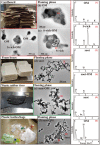Morphology, composition, and mixing state of primary particles from combustion sources - crop residue, wood, and solid waste
- PMID: 28698671
- PMCID: PMC5505958
- DOI: 10.1038/s41598-017-05357-2
Morphology, composition, and mixing state of primary particles from combustion sources - crop residue, wood, and solid waste
Abstract
Morphology, composition, and mixing state of individual particles emitted from crop residue, wood, and solid waste combustion in a residential stove were analyzed using transmission electron microscopy (TEM). Our study showed that particles from crop residue and apple wood combustion were mainly organic matter (OM) in smoldering phase, whereas soot-OM internally mixed with K in flaming phase. Wild grass combustion in flaming phase released some Cl-rich-OM/soot particles and cardboard combustion released OM and S-rich particles. Interestingly, particles from hardwood (pear wood and bamboo) and softwood (cypress and pine wood) combustion were mainly soot and OM in the flaming phase, respectively. The combustion of foam boxes, rubber tires, and plastic bottles/bags in the flaming phase released large amounts of soot internally mixed with a small amount of OM, whereas the combustion of printed circuit boards and copper-core cables emitted large amounts of OM with Br-rich inclusions. In addition, the printed circuit board combustion released toxic metals containing Pb, Zn, Sn, and Sb. The results are important to document properties of primary particles from combustion sources, which can be used to trace the sources of ambient particles and to know their potential impacts in human health and radiative forcing in the air.
Conflict of interest statement
The authors declare that they have no competing interests.
Figures










Similar articles
-
Optical and chemical characterization of aerosols emitted from coal, heavy and light fuel oil, and small-scale wood combustion.Environ Sci Technol. 2014;48(1):827-36. doi: 10.1021/es4028698. Epub 2013 Dec 20. Environ Sci Technol. 2014. PMID: 24328080
-
Analytical electron microscopy of combustion particles: a comparison of vehicle exhaust and residential wood smoke.Sci Total Environ. 2005 Jun 15;346(1-3):231-43. doi: 10.1016/j.scitotenv.2004.10.025. Epub 2005 Jan 15. Sci Total Environ. 2005. PMID: 15993697
-
Effective density and morphology of particles emitted from small-scale combustion of various wood fuels.Environ Sci Technol. 2014 Nov 18;48(22):13298-306. doi: 10.1021/es502214a. Epub 2014 Nov 3. Environ Sci Technol. 2014. PMID: 25365741
-
Efficiency of log wood combustion affects the toxicological and chemical properties of emission particles.Inhal Toxicol. 2012 May;24(6):343-55. doi: 10.3109/08958378.2012.671858. Inhal Toxicol. 2012. PMID: 22564093
-
Physicochemical characterisation of combustion particles from vehicle exhaust and residential wood smoke.Part Fibre Toxicol. 2006 Jan 3;3:1. doi: 10.1186/1743-8977-3-1. Part Fibre Toxicol. 2006. PMID: 16390554 Free PMC article.
Cited by
-
Evaluating emissions and air quality implications of residential waste incineration.Sci Rep. 2024 Sep 12;14(1):21314. doi: 10.1038/s41598-024-72173-w. Sci Rep. 2024. PMID: 39266580 Free PMC article.
-
Variation in Concentration and Sources of Black Carbon in a Megacity of China During the COVID-19 Pandemic.Geophys Res Lett. 2020 Dec 16;47(23):e2020GL090444. doi: 10.1029/2020GL090444. Epub 2020 Nov 28. Geophys Res Lett. 2020. PMID: 33349736 Free PMC article.
-
Effects of zinc chloride-silicone oil treatment on wood dimensional stability, chemical components, thermal decomposition and its mechanism.Sci Rep. 2019 Feb 7;9(1):1601. doi: 10.1038/s41598-018-38317-5. Sci Rep. 2019. PMID: 30733516 Free PMC article.
-
Characterization of Burning Behaviors and Particulate Matter Emissions of Crop Straws Based on a Cone Calorimeter.Materials (Basel). 2021 Jun 20;14(12):3407. doi: 10.3390/ma14123407. Materials (Basel). 2021. PMID: 34202949 Free PMC article.
References
-
- Heringa MF, et al. Investigations of primary and secondary particulate matter of different wood combustion appliances with a high-resolution time-of-flight aerosol mass spectrometer. Atmos. Chem. Phys. 2011;11:5945–5957. doi: 10.5194/acp-11-5945-2011. - DOI
Publication types
MeSH terms
Substances
LinkOut - more resources
Full Text Sources
Other Literature Sources
Miscellaneous

